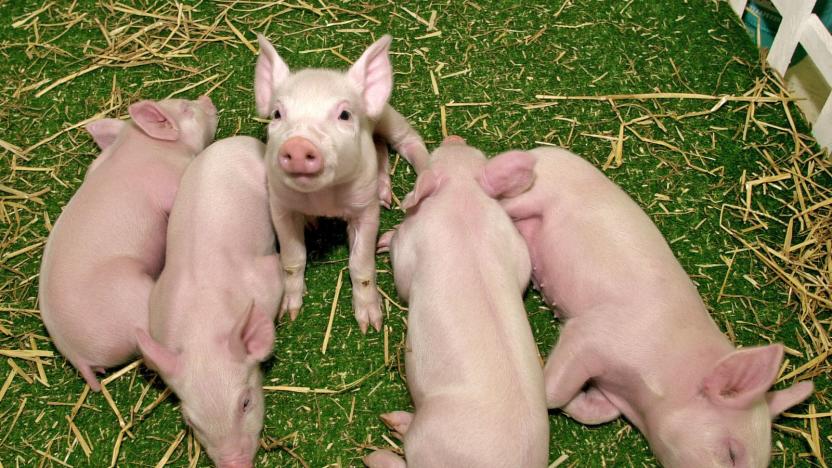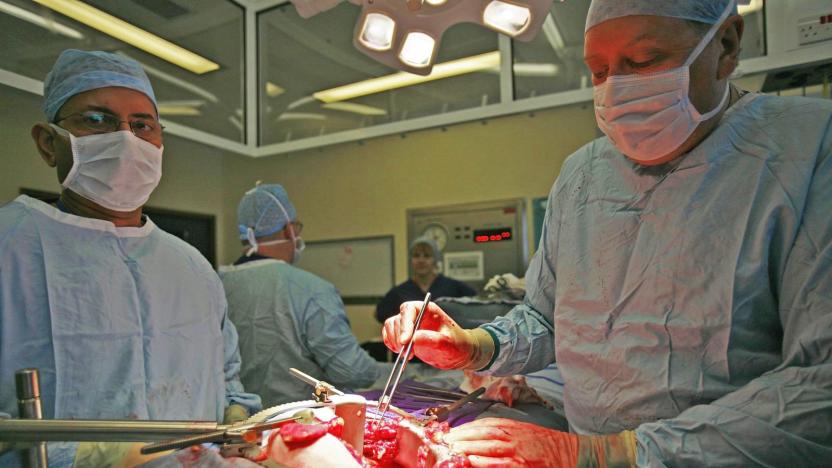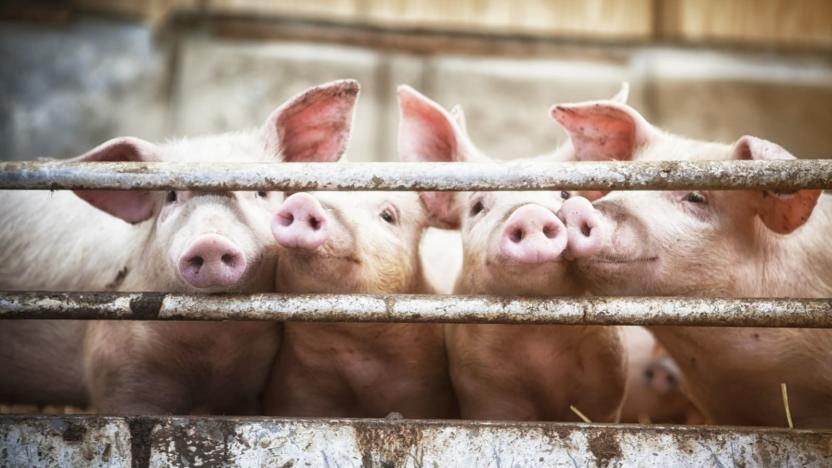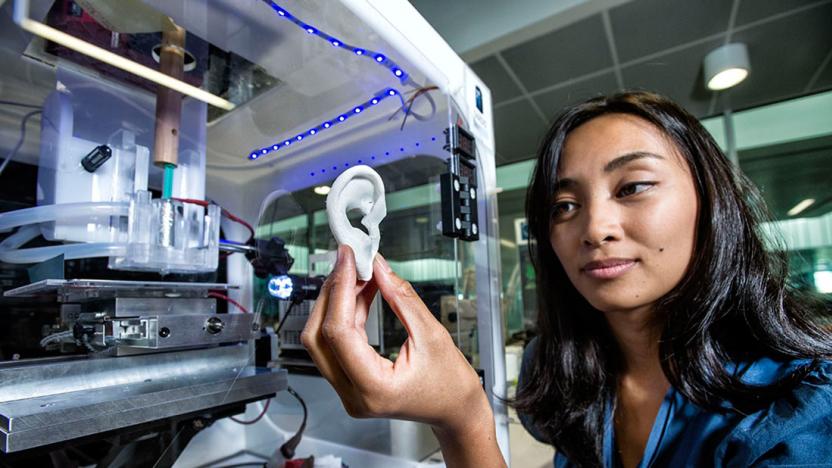organtransplant
Latest

Tomorrow's transplant organs could come from human-pig hybrids
With a lion's head full of gnashing teeth sitting atop the body of a goat and a snake for a tail, the Chimera of Greek mythology is a terrifying sight -- and that's before it starts breathing fire. Chimera have long served as cautionary touchstones in popular culture, often as examples of humanity's foolhardy quest to control nature. Take for example the tragic tale of Nina Tucker from Fullmetal Alchemist, the residents of The Island of Dr. Moreau or Sorry to Bother You's genetically-engineered slave race of Equi Sapiens. But in the medical field, chimera -- real life human-animal hybrids -- could hold the key to solving the global shortage of transplantable organs.

Someday, every piece of a person will be replaceable
In the past half decade, medical science has made tremendous advances in reproductive organ transplant techniques. In the span of just four years, we've seen the first successful penile transplant, the first child born from a transplanted uterus, and as of Monday, the world's first full male genital transplant surgery. During the 14 hour marathon operation, a team of doctors from Johns Hopkins University grafted the penis and scrotum from a donor cadaver onto a US military member who had had his own genitals destroyed during his service in Afghanistan.

Researchers are trying to make pig organs more viable for transplant
We have a huge supply and demand problem when it comes to organ transplantation. Closing that gap with animal-grown organs is an idea that's been on the table for some time, but it comes with a slew of issues that have prevented it from being a viable option. Pig organs are the right size for human transplants and are similar enough to our own, but pigs have viruses embedded in their DNA that could potentially infect humans and cause serious harm. However, a new study out today in Science shows that with the gene editing tool CRISPR, those viruses can be removed, bringing pig organs one step closer to human bodies.

Hospital to get first dedicated 3D tissue-printing facility
You still can't get a 3D-printed liver transplant made from your own cells, but an Australian hospital is trying to push the tech into the mainstream. The Queensland University of Technology (QUT) in Brisbane is building a dedicated "biofabrication" space where doctors and researchers can develop tech to model and print cartilage, bone and other human tissue. "It will be the first time a biomanufacturing institute will be co-located with a high-level hospital," said Australian Minister of Health Cameron Dick.

Scientists 3D-print embryonic stem cells, pave the way for lab-made organ transplants
3D printers already have a firm footing the commercial market, with more than 20 models available for well-heeled DIYers, and the technology's appeal isn't lost on the scientific community. A team at Heriot-Watt University in Edinburgh, Scotland has developed a method for 3D-printing clusters of human embryonic stem cells in a variety of sizes. Researchers have successfully printed 3D cells before, but this is the first time that embryonic cell cultures, which are especially delicate, have been built in three dimensions. Human embryonic stem cells can replicate almost any type of tissue in the human body -- and the scientists at Heriot-Watt believe that lab-made versions could one day be used to make organ transplants, thereby rendering donors unnecessary. In the nearer future, 3D-printed stem cells could be used to make human tissue models for drug testing; effectively eliminating the need for animal testing. Makes that Burritob0t look a little less ambitious, doesn't it?

Regenerative medicine pioneer continues changing lives with first successful laryngotracheal implants
Dr. Paolo Macchiarini is no stranger to world firsts, and less than a year after performing a synthetic windpipe transplant, the Karolinska Institute Professor has coordinated no less than two successful transplants of synthetic sections of larynx. Amazingly, both patients were able to breathe and talk normally straight after surgery, the basic functions we take for granted that they either struggled with or were simply unable to do before. The implants consisted of personally designed synthetic scaffolds coated with the candidates' own stem cells, so there's neither the chance of rejection nor the burden of life-long immunosuppressant therapy. Despite the amazing feat, Dr. Macchiarini ain't done yet, claiming this is the first of many steps towards building a synthetic, complete larynx -- voice box and all. Jump past the break for the official PR issued by Harvard Bioscience, the company responsible for growing what's in that tub.

First synthetic windpipe transplant paves way for post-op, immunosuppresive drug-free future
Science can do some wonderful, heartstring-tugging things. Take this for example: surgeons have triumphantly performed the first ever synthetic organ transplant. Cancer-stricken Andemariam Teklesenbet Beyene was the grateful recipient of this life-saving surgical breakthrough, performed by Prof. Paolo Macchiarini at Karolinska University Hospital in Sweden. The revolutionary operation comes with a zero rejection rate and requires no donor -- a huge relief for those stuck on lengthy waiting lists. Using a 3D scan of Beyene's windpipe, scientists at University College London crafted a highly-porous nanocomposite tracheal scaffold replica and covered it in stem cells harvested from his bone marrow. Within two days, the stem cells had worked their magic, weaving a brand new transplantable facsimile that is "indistinguishable from a normal healthy one." And since the procedure uses no foreign-born tissues, patients can look forward to a full-recovery sans mandatory immunosuppressive drugs, a major plus for post-op quality of life. With the surgery a success, Prof. Macchiarini's moving on to the next patient in need -- this time, a nine-month-old Korean baby with a malformed trachea. Doctors -- saving lives and warming hearts. Press release of the medically wondrous kind after the break.

Steve and the Governator mark transplant bill signing
In a ceremony commemorating California's SB 1395, the world's most well-known liver transplant recipient and the world's only former killer future robot turned politician posed for photos. Jobs and Schwarzenegger were at the Lucile Packard Children's Hospital in Stanford, CA to mark the signing of the transplant bill into law. Both men have been active sponsors of the measure, which establishes a live donor registry for kidney transplants and sets up a binary opt-in/opt-out system for organ donation via the DMV. While Californians were able to register as organ donors before when getting or renewing a driver's license, the new system requires that they explicitly choose to be a donor or not to be a donor. Jobs received a liver transplant in 2009; he chose to register as a transplant candidate in Memphis, TN rather than in California in order to improve his odds of getting a donor organ in time to salvage his health. In his remarks at the March announcement of the bill, Steve noted that 400 Californians died waiting for donor organs in 2009.

Steve Jobs helps push organ donation legislation
During a surprise appearance at the Lucile Packard Children's Hospital in Palo Alto, California, Steve Jobs joined California Governor Arnold Schwarzenegger to help advance organ donation legislation. Last year, Jobs flew to Tennessee to receive a liver transplant, and spoke briefly of this. "There were not enough livers in California to go around," he said, according to the San Jose Mercury News. "I was advised by my Stanford doctors to enroll on a list at a Memphis hospital, because it was more favorable to get a liver there. I was fortunate." And without the transplant, Jobs said, "I could have died." Steve Jobs returned to work at Apple in June 2009 and, according to the report, told other transplant survivors that he is currently feeling fine. "It's been a pretty good last few months." If passed, the legislation could help save more lives by making it easier for Californians to affirm their preferred organ donor status. The current system, says Jobs, "is an obscure process." Full text of the legislation, Senate Bill 1395, can be viewed here. To find out more about organ donation, visit Donate Life America, the Mayo Clinic's 10 myths of organ donation, and, lastly, state organ and tissue donor registries at OrganDonor.Gov. [via Silicon Alley Insider]






